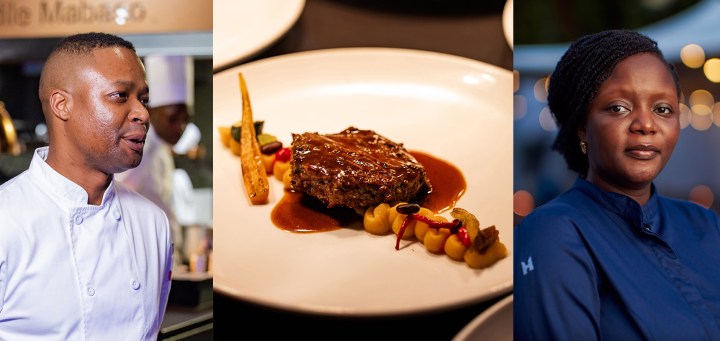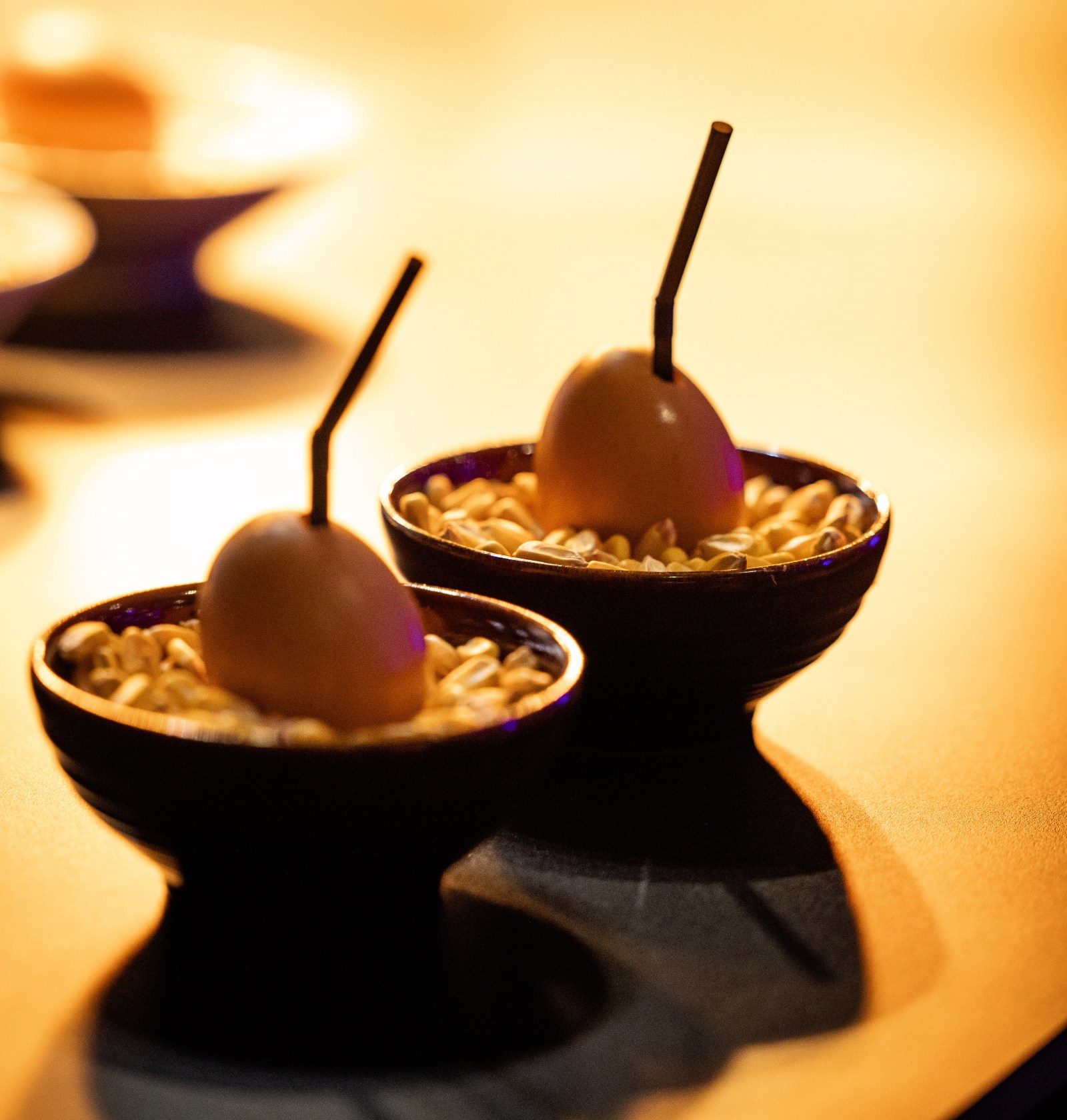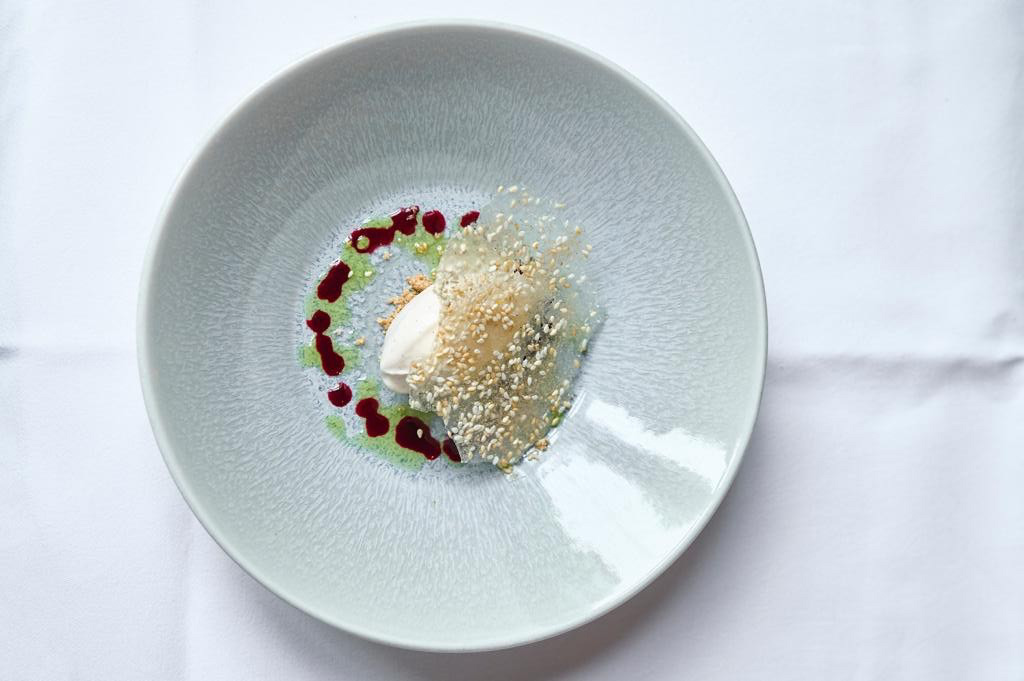SCOFF
When New African Cuisine came to Jozi

Johannesburg (almost) dined on a mat the other day when a cross-continental culinary collaboration served up insightful and deeply delicious dining.
It was a private function. For select clients of a bank at which I do not have an account. But I really wanted to be there, so I bombarded Boitumelo the PR person with overly eager WhatsApp messages. For weeks. My persistence paid off when a couple of the invited guests were unable to attend and, a few hours before the event, I was offered two of the hottest tickets in town. This is how a friend and I found ourselves at Les Créatifs savouring the culinary collaboration of Wandile Mabaso (Chef-Patron of the aforementioned Johannesburg palace of posh nosh) and Sierra Leone-born, Accra-based Chef Fatmata Binta from the Fulani Kitchen Foundation.
I am a fan of Chef Mabaso’s food, but I am fortunate to eat at his restaurant relatively often, so it was the prospect of an evening with Chef Binta that had caused me to nag poor Boitumelo incessantly. Chef Binta is a leading light in the New African Cuisine Movement which challenges Eurocentric assumptions about which food genres “belong” in fine dining restaurants. Along with chefs such as Dieuveil Malonga (of Meza Malonga in Kigali, Rwanda), Michael Elégbèdé (of Ìtàn Test Kitchen in Lagos, Nigeria), she creates innovative, upscale interpretations of traditional African tastes using heritage ingredients and techniques.
Tangible and intangible advantages flow from this edible art. Empowering economic and environmental benefits arise from the creation of equitable producers: consumer supply chains which also promote previously marginalised, climate crisis-resilient indigenous ingredients. Glamorous restaurant reconfigurations of classic flavours also create dialogue between tradition and modernity, breaking erroneous and harmful stereotypes and encouraging the association of African cuisine with avant-garde excellence.
Chef Binta has classic French training from the Kenyan Culinary Institute, but her food philosophy and flavour repertoire are chiefly inspired by her Fulani heritage and formative childhood experiences during the Sierra Leonean civil war. During this time, she experienced first-hand the power of food to bring people from different backgrounds together and, in so doing, dispel prejudice. Even before the war, traditionally nomadic pastoralist Fulani people frequently came into land use conflict with farmers from other communities but, faced with famine, neighbours came together to make communal meals with what little they had. She also witnessed the redemptive power of the fast-growing, drought-resilient, nutrient-rich ancient grain, fonio. Times have changed but both communal dining and fonio have remained central to the chef’s food habits.
In 2018 she created her now internationally acclaimed Dine on a Mat pop-up restaurant model. In 2022 she became the first African to win the prestigious Basque Culinary World Prize (BCWP). In its award announcement the BCWP committee noted that “her Dine on a mat, nomadic restaurant offers an immersive culinary experience across many countries that demonstrates how the Fulani people eat and interact with food. For them, sustainability is much more than a buzzword; it defines their way of life”.
Chef Binta is using the income from Dine on a Mat dinners conducted worldwide and the BCWP €100,000 prize money to fund the Fulani Kitchen Foundation, which she says “aims to empower and educate women as well as transform traditional ingredients and recipes from remote groups of Fulani into sources of income, economic autonomy, food security and employability”. She has purchased land to create a centre where women can “come to practise arts, crafts and other activities — including growing fonio — that are authentic to the Fulani people”.
Dine on a Mat dinners generally involve just that — sitting on a mat on the ground. She recently told the Guardian that this “is powerful for me, because I believe there’s something grounding when you sit on the floor. It creates space for compassion and empathy. When you’re on the ground all your guards are down.” This meal model has been implemented all over the world. So, imagine my surprise when I arrived at Les Créatifs to find damask-clothed tables and high-backed chairs.
The printed menu said Dine on a Mat so who knows why the standard format was not followed. Perhaps Les Créatifs doesn’t have sufficient storage space to stash the tables and chairs. Maybe the sponsoring bank thought their elite customers were too fancy for food on the floor. To criticise the hand that fed me when I was not supposed to be there at all seems cheeky and churlish but if ever there was a community in need of grounding, compassion and empathy, it is Johannesburg’s epicurean elite. As it was, my friend and I were perfectly happy talking to each other but, beyond exchanging names at the start of the evening, the couple opposite said not a word to us. We did try to initiate friendly interactions a few times, but they studiously avoided all eye contact. Once I thought that the man was trying to talk to me, but it turned out that he was summoning the sommelier to ask for more Johnny Walker Blue. We were all given a glass of the whisky as a pairing for our pudding, but he paid extra to secure the whole bottle.
The other disappointment was the absence of fonio. Chef Binta (who has cooked at Les Créatifs once before) explained this by saying that “we used so much of it last time that we thought we would reveal other aspects of Fulani food”. This was sad for me but completely reasonable in the broader scheme of things — a chef is so much more than a single ingredient — as fonio’s absence made space for yam, cassava and bean-based West African starches in the meal that followed.
The chefs bookended the event with signature dishes (amuse bouche for Mabaso, dessert for Binta) and the plates in between were a shared South meets West fusion. This resulted in delightfully compatible flavours because, as Chef Binta pointed out, “the ancestors that we pay homage to tonight and the food cultures we represent have more similarities than differences”.

Chicken broth served inside an egg shell at Les Créatifs. (Photo: Supplied)
Chef Mabaso started the night with heritage chicken broth served inside an eggshell — the contents of the egg had been painstakingly blown out so as to keep the oval exterior intact. Imbibed through a straw, the bird’s forthright flavour was powerfully apparent in both sips – the volume of an eggshell allowed for no more. Simultaneously simple yet stylish, meticulous and luxurious, it set the tone for the tastes to come.
Soup was followed by West African olele (soft, steamed black-eyed pea pudding) robust with scotch bonnet chilli and umami-intense dried crayfish stock. This soaked up sauce from a southern African-style indlubu bean and lamb stew which was topped with an ethereally light yet flavoursome atchar espuma.
Next came comfortingly familiar but also excitingly innovative suya (peanut, paprika, ginger, cayenne) spice-crusted Midlands-reared Wagyu with yam and chakalaka purée. This was drizzled with an imphepho-smoked, glistening, chestnut brown beef jus. The sacred herb’s aromatic edge was rich and redolent within the superb, deeply reduced sauce. Someone at Les Creatifs had clearly spent an entire day transforming a pot of liquid into a few cups of stock, and a cup of stock into two tablespoons of sauce. Definitely time well spent. It was all I could do not to run my finger around the edge of the plate.

Chef Binta’s baobab parfait with sesame textures and hibiscus jus. (Photo: Supplied)
The dessert, replete with African superfoods, was dazzling. Beautifully balanced layers of taste and texture began in a crackling crumble of nutty, salty sesame and golden gari (cassava couscous). Crunch gave way to the silken, sweet-sour smoothness of baobab-infused parfait. Creamy with a perfect hit of tart-tingling tang. Then the floral splendour of bissap rouge (hibiscus) jus and a sprinkle of verdant moringa powder. A ginger gelée that shimmied at the spoon’s touch completed an ensemble that beautifully reconfigured but retained all the essential ingredients of West Africa’s great ancient flavour repertoire.
Everything about the meal was impressive, but the pastry plate pulled it all together, creating a coherent conclusion. Each bite was beyond blissful. Sweet dreams are truly made of these.
So, was it worth all the begging and bothering of Boitumelo? Absolutely. Even without the full Dine on a Mat experience, I felt honoured to be part of such an innovative, insightful, empowering and deeply delicious event. DM





Comments - Please login in order to comment.